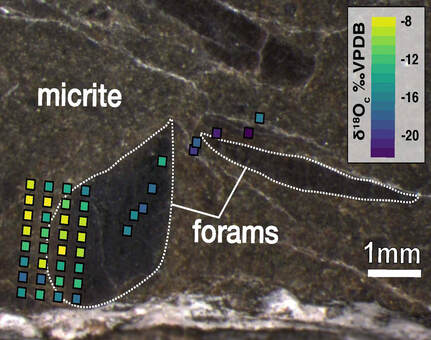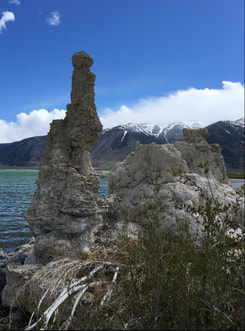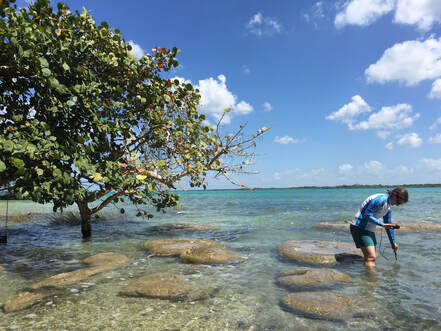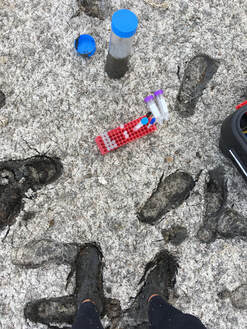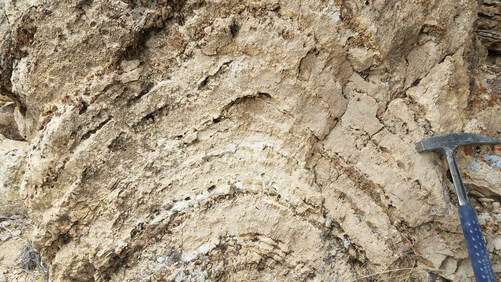Active Projects
Low-temperature carbonate alteration
|
How can low-T carbonate alteration be detected in the near-surface? Can we better understand basin thermal histories by combining time-temperature basin analyses with carbonate alteration models?
Carbonate rocks are a pillar in our understanding of the evolution of Earth’s oceans, atmosphere, and climate, as well as ancient terrestrial environments and tectonics. However, carbonate minerals are notoriously susceptible to post-depositional alteration of primary fabrics and isotopic values via dissolution-precipitation and solid-state reactions. Our team (Katie Snell [CU-Boulder], Brian Currie [Miami U], Ran and I) aims to identify unique textural and geochemical indicators of late-stage shallow alteration in terrestrial carbonate stratigraphy. The project technical and plain language abstracts can be found HERE from NSF's website. |
Lacustrine carbonates, microbes and alkalinity
1) What roles do microbial metabolisms play in the carbonate record of alkaline lakes?
The lacustrine carbonate record is one of our best archives of stable isotope proxy data from ancient terrestrial environments. However, localized hydrological inputs and microbial community composition can drive significant isotopic variability across lateral transects in a depositional basin. With collaborators at Weber State University and CU-Boulder, we partner sedimentological, geochemical, and isotopic data in modern lakes with active microbial carbonate precipitation to provide a framework for interpreting the lacustrine carbonate rock record.
The lacustrine carbonate record is one of our best archives of stable isotope proxy data from ancient terrestrial environments. However, localized hydrological inputs and microbial community composition can drive significant isotopic variability across lateral transects in a depositional basin. With collaborators at Weber State University and CU-Boulder, we partner sedimentological, geochemical, and isotopic data in modern lakes with active microbial carbonate precipitation to provide a framework for interpreting the lacustrine carbonate rock record.
2) Can kinetic isotope effects in fast precipitating carbonates be detected in the rock record of ancient alkaline environments?
The global carbon cycle links Earth's oceans and atmosphere. As such, reconstructing marine carbon chemistry (e.g. alkalinity, DIC, pH) during intervals of Earth history allows us to place constraints on the evolution of atmospheric pCO2 through time, and inform predictions of how ocean chemistry will respond to increasing pCO2. A theory exists that global oceans were more alkaline early in Earth history, during important periods of atmospheric and biological evolution. To explore this hypothesis, we make isotopic and sedimentological observations of carbonate facies indicative of fast precipitation from Archean and Paleoproterozoic shallow marine platforms and ramps. We ground truth our alkalinity interpretations with equivalent observations in Pliocene to modern hyperalkaline systems of the western USA.
The global carbon cycle links Earth's oceans and atmosphere. As such, reconstructing marine carbon chemistry (e.g. alkalinity, DIC, pH) during intervals of Earth history allows us to place constraints on the evolution of atmospheric pCO2 through time, and inform predictions of how ocean chemistry will respond to increasing pCO2. A theory exists that global oceans were more alkaline early in Earth history, during important periods of atmospheric and biological evolution. To explore this hypothesis, we make isotopic and sedimentological observations of carbonate facies indicative of fast precipitation from Archean and Paleoproterozoic shallow marine platforms and ramps. We ground truth our alkalinity interpretations with equivalent observations in Pliocene to modern hyperalkaline systems of the western USA.
Carbonate-associated phosphate (CAP): proxy for alkalinity and phosphate levels
Dissolved phosphate concentrations approximately scale with dissolved inorganic carbon in alkaline water. When phosphate is more-or-less proportionally incorporated into carbonate minerals that form in that water, P/Ca ratios can be used as an indicator of relative alkalinity, or Ca:ALK ratios. Understanding the carbonate chemistry of terrestrial and marine waters over Earth history allows us to answer questions about climate, atmospheric chemistry, basin geometry, etc., at specific points in time. In addition, the geochemical conditions under which earliest life formed on Earth are yet unknown, including the processes by which phosphate reached concentrations necessary for phosphorylation of prebiotic molecules without being titrated as apatite minerals ("the phosphate problem"). We use phosphate concentrations in rocks recording putative evidence for early life to assess paleo-alkalinity and phosphate levels in those environments, and to reconstruct phosphate levels in the oceans throughout Earth history to understand the role and limitations phosphate imposed on the evolution of life.
How do Earth's terrestrial environments respond to globally warm periods?
|
What does the carbonate record reveal about microbial community health and structure during globally warm periods, and localized intervals of warming, cooling, and resultant changes in aqueous geochemistry? How is stromatolite size and morphology related to aqueous geochemistry, basin geometry, and climatic conditions? |
Interdisciplinary, multi-proxy studies of tectonic terranes
How did Earth's major orogenic events participate in global climate change?
Tectonics play a key role in mediating Earth's climate through silicate weathering during uplift and erosion. We use reconstructions of ancient land surface elevations to test tectonic models for continental terranes. However, different approaches to reconstructing paleo-altitude often yield significantly discrepant results. For example, paleontological, isotopic, and palynological reconstructions of the Eocene Lunpola Basin of the southern Tibetan Plateau yield paleo-altitudes from sea level to >4 km above sea level. We seek to design inherently cross-disciplinary stable isotopic studies of biological materials to converge on refined elevation reconstructions for testing tectonic models.
Tectonics play a key role in mediating Earth's climate through silicate weathering during uplift and erosion. We use reconstructions of ancient land surface elevations to test tectonic models for continental terranes. However, different approaches to reconstructing paleo-altitude often yield significantly discrepant results. For example, paleontological, isotopic, and palynological reconstructions of the Eocene Lunpola Basin of the southern Tibetan Plateau yield paleo-altitudes from sea level to >4 km above sea level. We seek to design inherently cross-disciplinary stable isotopic studies of biological materials to converge on refined elevation reconstructions for testing tectonic models.
Publications (‡ denotes student or postdoc mentee)
In the pipeline
Ingalls, M., ‡Leapaldt, H.C., and Lloyd, M., Microbial autotrophy recorded by carbonate dual clumped isotope disequilibrium, in revision.
‡Leapaldt, H.C., Olsen-Valdez, J., Frantz, C.F., Snell, K.E., Trower, E.J., and Ingalls, M., Primary to post-depositional controls on the stable and clumped isotope record of shoreline sediments at Fayetteville Green Lake, in revision.
‡Meyers, K., ‡Martin, M., Kump, L., and Ingalls, M. Phase identification of phosphorus uptake onto carbonate minerals in coastal wastewater injection zones, in prep.
‡Wyman, A., Ingalls, M., ‡He, R., and Conroy, J., Kiritimati Lagoon temperature reconstruction from clumped isotopes, in prep.
Ingalls, M., Frantz, C.F., Olsen-Valdez, J., Snell, K.E., and Trower, E.J., Early diagenetic carbon cycling in shallow sediments of Great Salt Lake due to intra-annual microbial community succession, in prep.
Bojanowski, M.J., Ingalls, M., Kremer, B., Marciniak-Maliszewska, B., Matyszcazk, M., and Srodon, J., Lacustrine Mg-rich carbonates deposited in a cold, non-glaciated desert on Baltica during the Sturtian panglaciation, in prep.
2023
[19] Scheller, E.L., Ingalls, M., Eiler, J., Grotzinger, J.P., and Ryb, U., The mechanisms and stable-isotope effects of transforming hydrated carbonate into calcite pseudomorphs, GCA, doi: 10.1016/j.gca.2023.04.025.
2022
[18] Ingalls, M., Grotzinger, J.P., Present, T., Rasmussen, B., and Fischer, W.W., 2022, Carbonate-associated phosphate indicates elevated phosphate availability in Archean shallow marine environments, Geophysical Research Letters, https://doi.org/10.1029/2022GL098100.
[17] Ingalls, M., Fetrow, A.C., Snell, K.E., Frantz, C.M., and Trower, E.J., 2022, Lake level controls the recurrence of giant stromatolite facies, Sedimentology, doi: 10.111/sed.12967.
2021
[16] ‡Scheller, E.L., Grotzinger, J.P., and Ingalls, M., (2021) Guttulatic calcite: A carbonate microtexture that reveals frigid formation conditions, Geology, https://doi.org/10.1130/G49312.1.
[15] ‡Scheller, E.L., et al., including Ingalls, M., Formation of magnesium carbonates on Earth and implications for Mars, JGR: Planets, https://doi.org/10.1029/2021JE006828.
[14] Bernasconi, S.M., et al., including Ingalls, M., (2021) InterCarb: A community effort to improve inter-laboratory standardization of the carbonate clumped isotope thermometer using carbonate standards, Geochemistry, Geophysics, Geosystems, 22: e2020GC009588. https://doi.org/10.1029/2020GC009588.
[13] Ingalls, M., Snell, K.E., (2021) Tools for comprehensive assessment of solid-state and water-mediated alteration of carbonates used to reconstruct ancient elevation and environments, in Reaching New Heights: Recent Progress in Paleotopography special issue of Frontiers in Earth Sciences, doi: 10.3389/feart.2021.623982.
2020
[12] Smith, B.P., Ingalls, M., Trower, E.J., Lingappa, U.F., Present, T.M., Magyar, J.S., and Fischer, W.W. (2020) Physical and chemical controls on flat-pebble deposits: an analog from the Great Salt Lake, Utah, JGR: Earth Surface, 125(11), doi: 10.1029/2020JF005733.
[11] Ingalls, M., Blättler, C., Higgins, J., Magyar, J.S., Eiler, J., and Fischer, W.W. (2020) P/Ca in carbonates as a proxy for paleo-Ca:ALK and phosphate levels, Geophysical Research Letters, 47(21): e2020GL088804. doi: 10.1029/2020GL088804.
[10] Ingalls, M., Rowley, D.B., Currie, B.S., and Colman, A.S., (2020) Reconsidering the uplift history and peneplanation of the northern Lhasa terrane, Tibet, American Journal of Science, 320(6): 479-532, doi: 10.2475/06.2020.01.
[9] Ingalls, M., Frantz, C.M., Snell, K.E., and Trower, E.J., (2020) Carbonate facies-specific stable isotope data record climate, hydrology, and microbial communities in Great Salt Lake, UT, Geobiology, 18(5): 566-593. doi: 10.1111/gbi.12386.
2019
[8] Li, S., Currie, B.S., Rowley, D.B., Ingalls, M., Qiu, L., and Wu, Z. (2019) Diagenesis of shallowly buried Miocene lacustrine carbonates from the Hoh Xil Basin, northern Tibetan Plateau: Implications for stable-isotope based elevation estimates, Sedimentary Geology, 388: 20-36, doi:10.1016/j.sedgeo.2019.05.001.
[7] Ingalls, M. (2019) Reconstructing carbonate alteration histories in orogenic sedimentary basins: Xigaze forearc, southern Tibet, Geochimica et Cosmochimica Acta, 251: 284-300, doi: 10.1016/j.gca.2019.02.005.
2017
[6] Rowley, D.B., and Ingalls, M., (2017) Reply to ‘Unfeasible subduction?’, Nature Geoscience, 10: 879-880, doi:10.1038/s41561-017-0016-1.
[5] Ingalls, M., Rowley, D.B., Currie, B.S., Olack, G., Li, S., Tremblay, M., Schmidt, J., Shuster, D., Zeitler, P., Lin, D., and Colman, A.S., (2017) Paleocene to Pliocene low-latitude high elevation of southern Tibet: Implications for tectonic models of India-Asia collision, Cenozoic climate, and geochemical weathering, GSA Bulletin, 130(1-2): 307-330. doi: 10.1130/B31723.1.
2016
[4] Ingalls, M., Rowley, D.B., Currie, B.S., and Colman, A., (2016) Large-scale subduction of continental crust implied by India-Asia mass-balance calculation, Nature Geoscience, 9: 848-853. doi: 10.1038/ngeo2806.
[3] Currie, B.S., Polissar, P.J., Ingalls, M., Rowley, D.B. and Freeman, K.H., (2016) Multiproxy paleoaltimetry of the late Oligocene-Pliocene Oiyug basin, southern Tibet, American Journal of Science, 316(5): 401-436. doi: 10.2475/05.2016.01.
2015
[2] Li, S., Currie, BS, Rowley, DB, and Ingalls, M (2015) Cenozoic paleoaltimetry of the SE margin of the Tibetan Plateau: Constraints on the tectonic evolution of the region, Earth and Planetary Science Letters, 432: 415-424. https://doi.org/10.1016/j.epsl.2015.09.044.
2014
[1] Putnam, R., AF Glazner, DS Coleman, ARC Kylander-Clark, T Pavelsky, and M Ingalls (2014) Plutonism in three dimensions: field and geochemical relations on the southeast face of El Capitan, Yosemite National Park, California: Geosphere,11(4): 1-25.
Ingalls, M., ‡Leapaldt, H.C., and Lloyd, M., Microbial autotrophy recorded by carbonate dual clumped isotope disequilibrium, in revision.
‡Leapaldt, H.C., Olsen-Valdez, J., Frantz, C.F., Snell, K.E., Trower, E.J., and Ingalls, M., Primary to post-depositional controls on the stable and clumped isotope record of shoreline sediments at Fayetteville Green Lake, in revision.
‡Meyers, K., ‡Martin, M., Kump, L., and Ingalls, M. Phase identification of phosphorus uptake onto carbonate minerals in coastal wastewater injection zones, in prep.
‡Wyman, A., Ingalls, M., ‡He, R., and Conroy, J., Kiritimati Lagoon temperature reconstruction from clumped isotopes, in prep.
Ingalls, M., Frantz, C.F., Olsen-Valdez, J., Snell, K.E., and Trower, E.J., Early diagenetic carbon cycling in shallow sediments of Great Salt Lake due to intra-annual microbial community succession, in prep.
Bojanowski, M.J., Ingalls, M., Kremer, B., Marciniak-Maliszewska, B., Matyszcazk, M., and Srodon, J., Lacustrine Mg-rich carbonates deposited in a cold, non-glaciated desert on Baltica during the Sturtian panglaciation, in prep.
2023
[19] Scheller, E.L., Ingalls, M., Eiler, J., Grotzinger, J.P., and Ryb, U., The mechanisms and stable-isotope effects of transforming hydrated carbonate into calcite pseudomorphs, GCA, doi: 10.1016/j.gca.2023.04.025.
2022
[18] Ingalls, M., Grotzinger, J.P., Present, T., Rasmussen, B., and Fischer, W.W., 2022, Carbonate-associated phosphate indicates elevated phosphate availability in Archean shallow marine environments, Geophysical Research Letters, https://doi.org/10.1029/2022GL098100.
[17] Ingalls, M., Fetrow, A.C., Snell, K.E., Frantz, C.M., and Trower, E.J., 2022, Lake level controls the recurrence of giant stromatolite facies, Sedimentology, doi: 10.111/sed.12967.
2021
[16] ‡Scheller, E.L., Grotzinger, J.P., and Ingalls, M., (2021) Guttulatic calcite: A carbonate microtexture that reveals frigid formation conditions, Geology, https://doi.org/10.1130/G49312.1.
[15] ‡Scheller, E.L., et al., including Ingalls, M., Formation of magnesium carbonates on Earth and implications for Mars, JGR: Planets, https://doi.org/10.1029/2021JE006828.
[14] Bernasconi, S.M., et al., including Ingalls, M., (2021) InterCarb: A community effort to improve inter-laboratory standardization of the carbonate clumped isotope thermometer using carbonate standards, Geochemistry, Geophysics, Geosystems, 22: e2020GC009588. https://doi.org/10.1029/2020GC009588.
[13] Ingalls, M., Snell, K.E., (2021) Tools for comprehensive assessment of solid-state and water-mediated alteration of carbonates used to reconstruct ancient elevation and environments, in Reaching New Heights: Recent Progress in Paleotopography special issue of Frontiers in Earth Sciences, doi: 10.3389/feart.2021.623982.
2020
[12] Smith, B.P., Ingalls, M., Trower, E.J., Lingappa, U.F., Present, T.M., Magyar, J.S., and Fischer, W.W. (2020) Physical and chemical controls on flat-pebble deposits: an analog from the Great Salt Lake, Utah, JGR: Earth Surface, 125(11), doi: 10.1029/2020JF005733.
[11] Ingalls, M., Blättler, C., Higgins, J., Magyar, J.S., Eiler, J., and Fischer, W.W. (2020) P/Ca in carbonates as a proxy for paleo-Ca:ALK and phosphate levels, Geophysical Research Letters, 47(21): e2020GL088804. doi: 10.1029/2020GL088804.
[10] Ingalls, M., Rowley, D.B., Currie, B.S., and Colman, A.S., (2020) Reconsidering the uplift history and peneplanation of the northern Lhasa terrane, Tibet, American Journal of Science, 320(6): 479-532, doi: 10.2475/06.2020.01.
[9] Ingalls, M., Frantz, C.M., Snell, K.E., and Trower, E.J., (2020) Carbonate facies-specific stable isotope data record climate, hydrology, and microbial communities in Great Salt Lake, UT, Geobiology, 18(5): 566-593. doi: 10.1111/gbi.12386.
2019
[8] Li, S., Currie, B.S., Rowley, D.B., Ingalls, M., Qiu, L., and Wu, Z. (2019) Diagenesis of shallowly buried Miocene lacustrine carbonates from the Hoh Xil Basin, northern Tibetan Plateau: Implications for stable-isotope based elevation estimates, Sedimentary Geology, 388: 20-36, doi:10.1016/j.sedgeo.2019.05.001.
[7] Ingalls, M. (2019) Reconstructing carbonate alteration histories in orogenic sedimentary basins: Xigaze forearc, southern Tibet, Geochimica et Cosmochimica Acta, 251: 284-300, doi: 10.1016/j.gca.2019.02.005.
2017
[6] Rowley, D.B., and Ingalls, M., (2017) Reply to ‘Unfeasible subduction?’, Nature Geoscience, 10: 879-880, doi:10.1038/s41561-017-0016-1.
[5] Ingalls, M., Rowley, D.B., Currie, B.S., Olack, G., Li, S., Tremblay, M., Schmidt, J., Shuster, D., Zeitler, P., Lin, D., and Colman, A.S., (2017) Paleocene to Pliocene low-latitude high elevation of southern Tibet: Implications for tectonic models of India-Asia collision, Cenozoic climate, and geochemical weathering, GSA Bulletin, 130(1-2): 307-330. doi: 10.1130/B31723.1.
2016
[4] Ingalls, M., Rowley, D.B., Currie, B.S., and Colman, A., (2016) Large-scale subduction of continental crust implied by India-Asia mass-balance calculation, Nature Geoscience, 9: 848-853. doi: 10.1038/ngeo2806.
[3] Currie, B.S., Polissar, P.J., Ingalls, M., Rowley, D.B. and Freeman, K.H., (2016) Multiproxy paleoaltimetry of the late Oligocene-Pliocene Oiyug basin, southern Tibet, American Journal of Science, 316(5): 401-436. doi: 10.2475/05.2016.01.
2015
[2] Li, S., Currie, BS, Rowley, DB, and Ingalls, M (2015) Cenozoic paleoaltimetry of the SE margin of the Tibetan Plateau: Constraints on the tectonic evolution of the region, Earth and Planetary Science Letters, 432: 415-424. https://doi.org/10.1016/j.epsl.2015.09.044.
2014
[1] Putnam, R., AF Glazner, DS Coleman, ARC Kylander-Clark, T Pavelsky, and M Ingalls (2014) Plutonism in three dimensions: field and geochemical relations on the southeast face of El Capitan, Yosemite National Park, California: Geosphere,11(4): 1-25.
